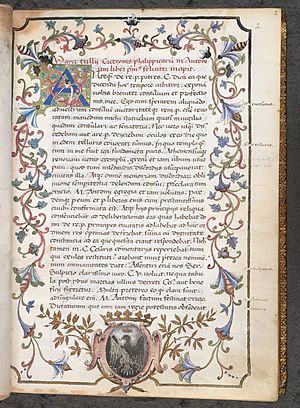King's manuscripts, British Library facts for kids

The King's manuscripts are a special group of 446 old handwritten books and documents. They are kept safe at the British Library in London. This amazing collection was first put together by King George III. Later, his son, King George IV, gave them to the British Museum in 1823. This gift was part of a larger collection known as the King's Library.
At first, these manuscripts were stored with printed books. But in 1840, they were moved to a special section just for handwritten items, called the Department of Manuscripts. However, the old maps from the collection stayed with the printed books. Today, these maps are in the Map Library and are known as the King's Topographical Collection.
Contents
What Are the King's Manuscripts?
A manuscript is a document or book written by hand, not printed. The King's manuscripts are a collection of these unique handwritten items. They include many different types of texts. You can find old stories, important letters, and even scientific writings among them. Each manuscript is like a piece of history, showing how people wrote and thought long ago.
These manuscripts are very important for understanding the past. They give us clues about history, art, and how people lived. Some of them are also beautiful works of art. They might have special drawings or decorations, known as "illuminations."
How King George III Started This Collection
The story of the King's manuscripts begins with King George III. He ruled Great Britain from 1760 to 1820. King George III loved books and learning. He was very interested in collecting old and rare items. Over many years, he gathered a huge number of books and manuscripts. He wanted to create a great library for his country. His collection became one of the most important in the world.
King George III spent a lot of time and money building this library. He bought manuscripts from all over Europe. He wanted to make sure that important knowledge and history were preserved. His passion for books helped create the foundation of what we see today.
From King to Public: The Big Move
After King George III passed away, his son, King George IV, inherited the collection. King George IV decided to do something very generous. In 1823, he gave his father's entire library to the British Museum. This was a huge gift to the nation. It meant that these valuable books and manuscripts would be available for everyone to study and enjoy.
This gift was a big moment for the British Museum. It greatly increased the size and importance of its collections. The King's Library, including the manuscripts, became a key part of the museum. It helped the museum become one of the world's leading centers for research and learning.
Special Maps and Drawings
Within the King's manuscripts, there was a special group of maps and drawings. These were not moved to the Department of Manuscripts in 1840. Instead, they stayed with the printed books. Today, this part of the collection is known as the King's Topographical Collection.
A "topographical" collection means it focuses on places and landscapes. These maps and drawings show how different areas looked in the past. They include detailed maps of towns, countries, and even battlefields. They are very useful for historians and geographers. This collection helps us understand how places have changed over time. It also shows the amazing skill of mapmakers and artists from long ago.

